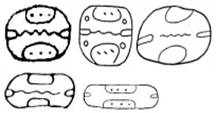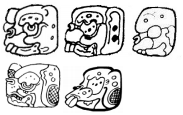
![]()
![]()
K&L.p24.r3.1-5 TOK.p20.r4.c1 BMM9.p16.r5.c3 = BMM9.p11.r4.c2
BAK BAAK BAK

25EMC.pdfp30.#3.1 = JM.p41.#1 25EMC.pdfp30.#3.2&3 = K&L.p24.r3.2&3
BAK BAK BAK




Austin MAM2021 Glyph Workshop Austin MAM2021 Glyph Workshop Austin MAM2021 Glyph Workshop Coll-1
PAL TI Sarcophagus Lid 36 PAL TI Sarcophagus Lid 41 PAL TI Sarcophagus Lid 51 YAX Lintel 10 F7a (bottom)
K’UH{ul}.<BAAK{el}:AJAW> K’UH{ul}.<BAAK{el}:AJAW> K’UH{ul}.<BAAK{el}:AJAW> u:BAAK



![]()
K&L.p24.r4.1-5 TOK.p22.r5.c2 BMM9.p15.r4.c1 25EMC.pdfp30.#3.7 = JM.p41.#2
BAK BAAK BAK BAK BAK
[25EMC.pdfp30.#3.5&6 = K&L.p24.r4.5&1]
BAK



PAL Temple of the Inscriptions Sarcophagus Lid 27 PAL ToS E11 YAX Lintel 10 C4
<K’UH{ul}>.<BAAK:AJAW> BAAK:le <AJ:<[k’a]ba>:la>.<BAAK:ki>

![]()
![]()
K&H.p30.fig11 IXZ stela 4 B3 K&L.p24.r3.5-6 25EMC.pdfp30.#3.4 = K&L.p24.r3.5 Coll-1
YAX Lintel 10 F5a (bottom)
BAK BAK BAK u:BAAK
· No glyphs given in K&H (in the logogram-list).
· Listed twice in BMM9 – once under “Simple Signs” and once under “Parts of Human Body”.
· The word baak could mean either “captive” or “bone” in Classic Maya. It’s unclear to me whether they are the same etymon which developed two independent meanings (from an etic point of view), or they were two independent etymons which were homonyms (or evolved into being homonyms). In the former case, it has been suggested that the primary meaning was “bone” and – as a bone could be moved around and manipulated and cut up according to the wishes of its owner – this was extended to mean a “captive” as well, as they too could be moved around and manipulated and cut up, according to the wishes of their “owner”.
· Variants (3):
o A. Abstract (evolved from the representational form?) – features:
§ Boulder or oval.
§ With a tiny dot at each end of the “long” axis, and with a squiggly line between them representing the marrow.
§ On the opposite ends of the “short” axis, optionally, two small ovals, optionally with 3 tiny non-touching dots in a line.
Caution: on rare occasions BAAK can be written with the long axis vertical. Do not confuse this with the visually similar (but also rare) variant of bo (K&H.p30.fig11: IXZ Stela 4 A4).
|
|
Get example |
|
K&H.p30.fig11 IXZ Stela 4 A4 <u:CHAN:na>.<bo:bo> |
|
o B. Skull / animal head – features:
§ Skull has two fangs at the left (outside) of the mouth, sticking downwards or slightly forwards (i.e., can be rather “CHAPAAT”-like).
§ Eye protector is a kidney-shaped element with three tiny, non-touching dots – usually in a straight line, but occasionally in an arc, optionally with the middle dot slightly larger.
§ Optionally, a long vertical element on the right, with internal non-touching circles of varying size, with one or more cross-hatched. It can resemble an o or a WAL. This can be reduced to just the non-touching circles – for example, it is the diagnostic for YAX Lintel 10 C4, to distinguish it from XOOK (plus it has a downturned nose, while XOOK would have an upturned nose).
§ Stuart-PTotS.p1 explains that this is, iconographically speaking, the skull of a deer:… baak, “bone,” is perhaps related to the standard Palenque emblem glyph, the head variant of which is a deer skull. [Sim: the two distinctive teeth in the front of the mouth strike me as unusual, in connection with a deer skull.]
§ Do not confuse this head variant of BAAK with the visually similar CHAPAAT. The shared characteristics are because insects and other arthropods were associated with “boniness”. The major differences are:
· BAAK does not have a “scroll” within the top part of the head, which CHAPAAT (often) does.
· The mouth is (usually) closed in BAAK and (usually) open in CHAPAAT (cases of the opposite are known).
o C. Representational – features:
§ A single bone with 4 knobby ends.
§ Tiny dots at each of the 4 ends.
§ A squiggle representing the marrow.
· K&L imply that the head form is used only to write “bone”, not “captive”: Dorota Bojkowska: the wording is not strong enough to conclude this.
· Gronemeyer-TMSoT.p36.pdfp14.para5.l-3: [BAAK is used as the EG for] Palenque, Tortuguero, and Comalcalco.
· Do not confuse (one of) the abstract variants of BAAK with the abstract variant of CHAK. They are visually somewhat similar in that both can have an internal oval on each of the long sides, with three non-touching dots in the oval. The difference is that:
o BAAK has a wavy or dotted line running through the middle of the glyph, connecting the (larger) dot at one end to the (larger) dot at the other. This line runs along the long axis of BAAK, perpendicular to the axis of the two parallel cross-hatched bands of CHAK.
o CHAK has two parallel cross-hatched bands running through the middle of the glyph, connecting the two ovals. These bands run parallel to the short axis of CHAK, perpendicular to the axis of the wavy or dotted line of BAAK.
![]()
JM.p41.#4
ba:ki
